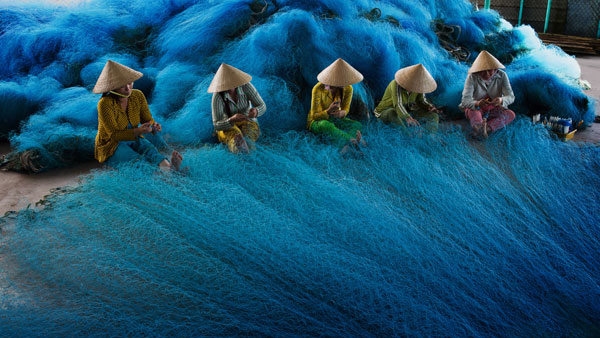


|
Do Tuyet Trinh’s photograph
"Fishing Net Making in Mekong Delta” was displayed at the "Atkins CIWEM
Environmental Photographer of the Year
The Ho
Chi Minh City Photography Association in August 2017 announced the winners of
its photo contest themed ‘Vietnam from Above’. Most of the award-winning
photos went to entrants who had used fly cameras to capture the stunning and
charming landscapes of Vietnam as seen from a different view, including the
photo ‘Ca Mau Cape’ by Nguyen Vinh Hien (first prize), ‘Salt Field by Nguyen
Tien Dung (second prize), and ‘Harvesting’ by Duy Bang (consolation prize).
The use
of fly-cam drones has become popular over the past few years and has not
waned yet. The recently-concluded Youth Photography Festival also awarded
prizes for photos taken by drones. Photos using the same techniques even
shined at regional photo contests.
It can be
seen that over 90% of Vietnamese photos which have won international prizes
so far have shared a common feature of promoting tourism. Many foreign
photographers visiting Vietnam have also concluded that Vietnam is a perfect
country for taking pictures.
Women
making fishing net in the Mekong River delta – a photo by Do Tuyet Trinh
which was selected for the Atkins CIWEM Environmental Photographer of the
Year in 2014, marked the start of photographers flocking to coastal areas,
from Phan Thiet city to Bac Lieu province, in order to capture fishing nets.
The stereotype then rapidly recorded triumphs in many arenas in Smitsonian
(the US), Priofy (Australia) and FIAP in Europe.
Another
typical example is the image of catching fish on Tuyen Lam lake, Da Lat city,
in the Central Highlands province of Lam Dong, in which a fisherman boating
on the lake with his fishing net casting a shadow on the lake’s surface which
is shrouded in a curtain of hovering mist. Such photos have been duplicated
like mushrooms at exhibitions and galleries so frequently that they look
exactly the same. Then there are the frames of terrace fields, salt fields,
spectacular sunsets and picturesque sunrises.
Are those
photos beautiful? Of course, they are. However, when the photos are seen
every where from forums to galleries, they can become boring for viewers.
They may provide a fresh look to international judges, who might not have yet
observed the scenes.
While
assessing tourism photography, the examination of a new place, cultural
practices and the daily life of local residents are always highly
appreciated. That is the reason why portraits of ethnic groups in mountainous
regions, the Central Highlands and northwest areas in their traditional
costumes with their eyes wide open were the favourite theme of many
Vietnamese contemporary photographers.
The
overuse of photo editor applications is another concerning issue among
Vietnamese contemporary photography. It seems that the obsession on making
glossy and perfect frames urge the photographer to apply technology every
time they shoot.
For many
years, there have been countless pictures with dramatic editing submitted to
photo contests, even when the organisers make a clear announcement that
photoshop is not allowed. A number of photos featured a fishing boat
struggling in a heavy storm and enormous waves but it turned out that the
storm was a product of photoshop and that the photo had been taken in
tranquil weather.
The
photographers’ sophistication in applying photo editing has become more
professional so that the retouches on their photos are unrecognisable.
However, the "professionalism” is not encouraged and cheating among young
photographers is unacceptable.
Looking
at the entries sent to a number of photo contests today, it is sad to realise
that the contests are no longer a platform for photographers but for
"photoshop-graphers” instead.
The
dominance of photos on natural landscapes, portraits, and daily cultural
practices might have created impressions on viewers at first sight, but they
look so familiar that they have failed to nail an unforgettable experience on
viewers.
There are
quite a few photographers who pursue photojournalism but their works have not
yet captured the "decisive moment” in photography.
In
addition, not many Vietnamese photographers have developed long-term projects
or shown advantages in their photo collections. Most of them have struggled
in expression or in setting out a clear arrangement of their photo
collections, which should open with an introductory photo and then follow
with key photos. Instead of telling a compete story, their photo set is a
group of single photos featuring the same theme but from different angles.
Vietnamese
photographers have not invested much in writing captions for their photos.
They simply describe their photo generally rather than providing viewers with
detailed information on the photos, where it was taken, how it was taken, or
the story behind it.
The
development processes have brought about challenges to human life in various
fields of environment, urbanisation, and the explosion of technology.
However, such pressing issues have not yet been fully captured through the
lenses of contemporary Vietnamese photographers.
|